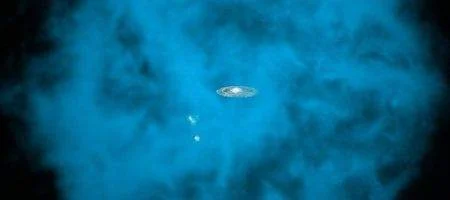Our Milky Way Galaxy is surrounded by an enormous halo of hot gas hundreds of thousands of light years across, and with as much mass as all the stars in the galaxy.

The discovery, made by NASA’s Chandra X-ray Observatory, could explain what is known as the ‘missing baryon’ problem.
Baryons are particles, such as protons and neutrons, that make up more than 99.9 percent of the mass of atoms found in the cosmos. By observing extremely distant gas halos and galaxies, astronomers have found that when the universe was only a few billion years old, baryonic matter represented about one-sixth the mass and density of dark matter.
Now, though, some 10 billion years later, at least half the baryons are unaccounted for.
Chandra has observed eight bright X-ray sources located far beyond our galaxy.These X-rays are absorbed selectively by oxygen ions near the galaxy, with calculations showing that the temperature of the absorbing halo is between 1 million and 2.5 million kelvins, or a few hundred times hotter than the surface of the sun.
“We know the gas is around the galaxy, and we know how hot it is,” says researcher Anjali Gupta. “The big question is, how large is the halo, and how massive is it?”
To try and answer this, the team supplemented Chandra data on the amount of absorption produced by the oxygen ions with XMM-Newton and Suzaku data on the X-rays emitted by the gas halo. They concluded that the mass of the gas is equivalent to the mass in more than 10 billion suns – perhaps, even, as large as 60 billion suns.
“Our work shows that, for reasonable values of parameters and with reasonable assumptions, the Chandra observations imply a huge reservoir of hot gas around the Milky Way,” says Smita Mathur of Ohio State University in Columbus.
“It may extend for a few hundred thousand light-years around the Milky Way or it may extend farther into the surrounding local group of galaxies. Either way, its mass appears to be very large.”






